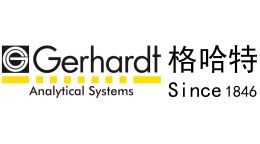可生物降解(3-羟基丁酸酯)-(4-羟基丁酸酯)聚合物(PHA聚羟基脂肪酸酯)薄膜样品的提取
检测样品 可降解材料
检测项目 含量
方案详情文
智能文字提取功能测试中
生产广泛应用的各种单体比可生物降解(3-羟基丁酸酯)-(4-羟基丁酸酯)聚合物(PHA聚羟基脂肪酸酯)薄膜Production of Various Monomer-Ratio Biodegradable Poly(3-hydroxybutyrate-co-4-hydroxybutyrate) Films for Wide Range of ApplicationsPreprints (www.preprints.org)NOT PEER-REVIEWED|Posted: 28 April 2022doi:10.20944/preprints202204.0284.v1 生产广泛应用的各种单体比可生物降解(3-羟基丁酸酯)-(4-羟基丁酸酯)聚合物(PHA聚羟基脂肪酸酯)薄膜 Article Production of Various Monomer-Ratio Biodegradable Poly(3-hnyydroxybutyrate-co-4-hydroxybutyrate) Films for Wide Range of Applications Aneta Pospisilova1,Juraj Vodickal, Monika Trudicoval, Zuzana Jugloval, Jiri Smilekl, Premysl Mencik, J i ri Masilko1, Eva Slaninoval, Veronika Melcoval, Michal Kalinal, Stanislav Obrucal and Petr Sedlacek1* 1F Faculty of Chemistry, Brno University of Technology, Purkynova 118, 612 00 Brno, Czech Republic * Corresponding author: Petr Sedlacek, sedlacek-p@fch.vut.cz; Tel.: +420 541 149 486 Abstract: F i lms prepared from poly(3-hydroxybutyrate-co-4-hydroxybutyrate) copolymers pro-duced by Aneurinibacillus sp. H1 using an automatic f ilm appl i cator were homogeneous and had a defined thickness, which allowed a detailed study of physicochemical properties. Their properties were compared with a poly (3-hydroxybutyrate) homopolymer fi lm prepared by the same proce-ure, which proved to be significantly more crystalline by DSC and XRD. Structural differences between samples had a major impact on their properties. With increasing 4-hydroxybutyrate con-tent, the duc t ility and release r ate of the model hydrophilic active i ngredient i ncreased significantly.Other observed propert i es, such as the release of the hydrophobic active substance, the contact angle with water and ethylene glycol , or t he surface morphology and roughness, were also affected by the composition. The identified properties predetermine these copolymers for wide use in areas such as biomedicine or smart biodegradable packaging for food or cosmetics. The big advantage i s the possibi li ty of fine-tuning properties simply by changing the fermentation condi t ions Keywords: polyhydroxyalkanoates (PHA); P(3HB-co-4HB); Aneur i nibacillus sp. H1; mechanical properties; surface morphology; crystallinity; active ingredients release 1.Introduction In the course of the last two centuries, plastics became an inseparable part of human life. Robustness of these materials ensures wide-scale applicability as long-life products.Great variety of i ts mechanical properties also favours its use in consumer products, such as packages or coatings. How W e e v Ve er, environmental aspects played an influential role against petrochemical plastics within the last decades. Therefore, a generation of biode-gradable polymers became a very promising substi t ute for commerc i a l plastics, especially in the consumption segment. Amongst these polymers, polyhydroxyalkanoates (PHA) at-tract great attention due to their biocompatibility and full biodegradability [1]. PHA family cover wide range of polymers including homopolymers and copolymers composed of large variety of monomers. Numerous monomeric compositions provide great variability in physical and mechanical properties facilitating several applicability directions. Until now, more than 150 different monomers of PHA were described,how-ever only a few of them are relevant to large-scale applications due to production availa-bility and final impact on the final product properties [2]. The properties of PHA materials are also reflected in monomers ratio in the polymer chain, hence, materials properties could be tailored to specific requirements by managing the polymer composition. Though,adjusting the monomer ratio of copolymers is possible, i t is quite unique for biotechno-logica l productions of PHA. Fortunately, a thermophi l ic bacterial strain Aneurinibacillus sp. H1 has appeared as this kind of optimal producent if cultivation conditions are con-trolled [3]. Aneurinibacillus is remarkable producent of poly(3-hydroxybutyrate-co-4-hy-droxybutyrate) copolymer able to incorporate 4-hydroxybutyrate (4HB) units up to 90 mol .% by uti l ising 1,4-butanediol as a precursor, whi l e the monomer ratio in the final co-polymer is mirrored to carbon sources (precursor) ratio in the medium [3]. In addition,this thermophilic bacterial strain i s also able to produce terpolymer consisting of 3-hy-droxybutyrate, 4-hydroxybutyrate and 3-hydroxyvalerate, and does not produce toxic en-dotoxins [3]. These copolymers seem to be suitable polymers for thin f ilms production,due to i ts favourable mater i al properties for different applications [4], [5]. Polymer films represent large segment of industry, where the annual consumption of these materials in EU reaches dozens of megatons. Films are used in packaging, as in-sulation, or protective layers for sensitive surfaces [6]. The vast majority are made of con-Ve o nal polymers, especially polyethy l ene and polypropylene. However, in some seg-m ents there is a demand for biodegradable and biobased alternatives in which PHAs could be applied. Materials of various chemical, optical and mechanical properties are used . Of the mechanical ones, tear strength, elongation at break, modulus of elasticity,impact strength, tear resistance, and tear propagation are the most important. However,properties of films also largely depend on additives, surface modifications and manufac-turing methods. F i lms are usually made by thermoplastic film forming or solution cast i ng,where the latter option i s advantageous for thermally unstable or very high-mel t ing ma-terials. Of the conventional plastics, this applies to cellulose acetate, polyimide and poly-carbonate [7]. The advantage of solution casting is also the possibility of adding tempera-ture-sensitive additives directly during film production. Such additives may improve the physical properties of the f ilm or may be added as active ingredients for sustained release. Within this paper, we introduce two different P(3HB-co-4HB) copolymer f ilms pro-duced by employment of Aneurinibacillus sp. H1 in targeted cultivations and formed by multi-layer solution casting technique. This production represents model manufacture of such materials aiming to exploration of basic applicability options. As a reference, homo-polymer of 3-hydroxybutyrate was produced by well-described bacterium Cupriavidus ne-cator, and further investigated to evaluate advantages of 4HB incorporation in the poly-mer chain. The outputs of this research should serve as background for further particular research with respect to specific applications. 2. Materials and Methods Polymer materials used for this study correspond to materials used for degradation tests publ i shed previously [8]. The materials production was provided by the same pro-cedures. We also introduce some properties relevant to this study, which were previously presented in stated paper, especially the films thickness (determined by mechanical pro-filometry) and average molecular weight (determined by size exclusion chromatography). 2.1. PHA production Preparation of the PHAs and polymer films was previously described in [8]. For the purpose of PHAs production, two bacterial strains were employed - Cupriavidus necator H16 for P(3HB) biosynthesis and Aneurinibacillus sp. H1 for copolymers of 3-hydroxy-butyrate and 4-hydroxybutyrate production. To prepare the inoculum, complex media Nutrient Broth (10 g/L beef extract, 10 g/L peptone, 5 g/L NaCl) were used for bacterial growth. Media were incubated at 30℃ and 45℃ for Cupriavidus and Aneurinibacillus,respectively, while shaking at 180 rpm for 24 h. Afterwards, mineral salt medium (MSM)was used for PHA production, the inoculum ratio was 10 vol.%. MSM for C. necator con-sisted of : KHzPO4, 1.02 g/L; (NH4)2SO4, 1.0 g/L;NazHPO412 HzO, 11.1 g/L, MgSO47HzO,0.2 g/L; trace element solution (TES, composition see Table S1, supplementary materials),1 mL/L; as a carbon source, 20 g/L of fructose has been used. As the MSM for Aneurini-bacillus, following components were used: NazHPO412 HzO, 9.0 g/L; KHzPO4, 1.5 g/L;MgSO47 HzO,0.2 g/L;NH4NO3,1.0 g/L; CaCl2-2 HzO,0.02 g/L;FE"NH4citrate,0.0012 g/L;Tryptone, 0.5 g/L and microelement solution (MES, composition see Table S2, supplemen-tary materials), 1 mL/L. To produce P(3HB-C0-4HB) copolymer,1,4-butanediol and glyc-erol i n two various ratios were used:4 g/L of 1,4-BD and 6 g/L of glycerol for lower 4HB- content polymer production, 4 g/L of 1,4-BD and 2 g/L of glycerol for polymer richer i n 4HB. Productions were performed in 100 mL Erlenmeyer f lasks incubated at 30 ℃ (Cu-pr i avidus necator) and 45℃ (Aneurinibacillus) for 72 h under shaking of 180 rpm. Grown media were centrifuged (4800 g, 10 min) in order to collect bacterial cells, the biomass was dried at 70 ℃ in Petri dishes. Acquired biomasses were determined gravimetrically as the cel l dry mass (CDM), the PHA content and monomeric composition were determined by Gas Chromatography as described by Obruca et al.-see ref. [9]. To obtain the polymers,chloroform extractions were carried out at SOXTHERM@ automatic extraction system (C.Gerhardt Analytical systems, Konigswinter, Germany). 2.2. Films product i on Preparation of the PHAs and polymer f ilms was previously described in [8]. Briefly,extracted polymeric materials were dissolved in chloroform to 5% w/w concentration.Viscous solutions were filtered through 5um-nylon filters. To generate films, an automatic film applicator (QTC Sheen, Capelle aan den IJssel, Netherlands) was employed, each film was prepared by application of two l ayers of solution (120 um thickness). After solvent evaporation, film thickness was determined by mechanical profilometry (Bruker, Billerica,Massachusetts, USA). 2.3. Size Exclusion Chromatography The method for the average molecular weight determination was described previ-ously [8]. Samples of f ilms were dissolved in HPLC-grade chloroform in concentration of 1.5 mg/mL. The solutions were filtered through 0.45 um nylon filters and injected (100uL) to the size exclusion chromatography system (Infinity 1260 system with PLgel Mixed-C column, Agilent, Santa Clara, USA) coupled with the multi-angle light scattering detec-tor (Dawn Heleos II, Wyatt Technology, Santa Barbara, USA) and differential refractome-ter (Opt i lab T-rEX, Wyat t Technology, Santa Barbara, USA). The mobile phase (HPLC-grade chloroform) was pre-filtered through 0.02 um membrane f ilters, the f low rate was adjusted to 0.6 mL/min. The raw data were processed in ASTRA software (version 7.3.2,Wyatt Technology, Santa Barbara, USA), the weight-average molecular weight (Mw) was calculated by using Zimm equation. 2.4. Atomic force microscopy Surface morphology of P3HB and copolymers P3HB-co-4HB was determined by QI mode (quantitative imaging mode) using JPK Nanowizard 4 AFM (Bruker, Billerica, Mas-sachusetts, USA). Rectangular geometry TESPA-V2 (radius 7 nm, resonance frequency 312 kHz, spring constant 33 N/m) was used for the surface imaging of f ilms. Spring con-stant as well as resonance frequency were experimentally determined during calibration (free oscillation of the probe far enough from the sample surface in the air). P3HB or ap-propriate copolymers were placed on microscope s l ide (dried before measurement) and measured in tapping mode under air condition. The following parameters were chosen:setpoint -2,7 nN, Z-speed-50 mm/s, scan size-50 mm, resolution-512×512. Images of surface topography were subsequently processed in JPK DP Data Processing software with following steps: Line levelling - linear; Smooth QI images - no, interpolation- yes.Surface of P3HB and copolymers with 4HB were imagined in pixel difference 3D mode.No further images adjustments were carried out. 2.5. Contact angle measurements Sessi l e drop test was performed on Advex Instruments See System E/S. 5 ul drop of the respective solvent was placed on a polymer film surface using a microsyringe. Contact angles were calculated automatically by the implemented software See System 7.0. Each measurement was repeated seven times. 2.6. Tensile tests The elongation at break, the Young’s modulus, and the tensile strength were deter-mined using the universal testing machine Zwick Z 010 (ZwickRoell GmbH & Co., Ulm,Germany) at ambient conditions. Average values of at least seven measurements were reported. Measurements were carried out using the load indicator with the maximal ten-sile force of 10 N and with pneumatic grips. Pre-load was 0.1 N and the deformation rate was 5 mm/min. The 5A double-paddle testing samples were cut from the films and heated to 110°℃ for 1h in order to remove residual solvent and enhance crystallisation. Thickness of each specimen was measured before the tensile test. 2.7. X-ray Diffractometry (XRD) XRD patterns were collected using the X-ray diffraction analyzer EMPYREAN(PAN-alyt i cal , Malvern, United Kingdom) in a central focusing arrangement with Bragg-Bren-tano parafocusing optics using CuKa radiation (range: 5-90°2th, step: 0.013°2th, voltage:40 kV, current 30mA), ADS: 10 mm, t ime per step: 96 s, without monochromator. 2.8. Active ingredients release kinetics Active ingredients release kinetics was modelled with two different dyes - hydro-philic Rhodamine 6G and hydrophobic Nile red. As a polar environment for Rhodamine release, distilled water was selected. For hydrophobic eluate release, water solution of Polyoxyethylene (20) oleyl ether (Brij@O20, Sigma Aldrich) was used as the solubilizing agent. Dye was added to polymer solution to consequential concentration of 1 g/L. Sub-sequently, f ilms were prepared as described above. Pieces of 2.6x2.6 cm-coloured films were incubated in solvent for 48 h. Amount of released dye was determined spectromet-rically at 524 nm for Rhodamine and 561 nm for Nile red detection. 3. Results and Discussion 3.1. PHA films production The PHA productivity of Aneurinibacillus sp. H1 i s generally lower than the one of C.necator. Compared to C. necator, Aneurinibacillus sp. H1 reaches lower cell dry mass/bio-mass yields and the obtained biomass is quite poor at PHA content, as compared to C.necator (see Table 1). Furthermore, produced copolymers dispose of significantly lower average molecular weigh t than homopolymer. On the other hand , manipulating the mon-omer composition is expected to broaden the range of accessible physical and material properties (crystallinity, ultimate tensile strength), resulting i n higher applicability. In ad-dition, thermophilic strains (or generally extremophiles) offer numerous advantages for biotechnological productions if employed , such as lower sterility requirements and less cooling need [10], which partially offset lower process yields. Hereby, we present basal differences in physical properties in order to i llustrate the motivation of P(3HB-Co-4HB)production by Aneurinibacillus sp. H1, since we are able to set physica l properties of the product by simple choice of cultivation strategy. Accordingly, we would l ike to point out first two columns of the Table 1 as the key results presented here. Therefore, not al l of stated aspects are accountable or projectable in the final production costs, and the stimu-lus of P(3HB-co-4HB) copolymers production by Aneurinibacillus sp. H1 should definitely follow the requirements on final product properties (purposes) presented in this paper. Table 1. Results of polymers production - also in [8]. Sample Substrate (g/L) CDM PHA (% per CDM) Mw (kDa) Crystallinityt (%) P3HB fructose 9.06± 0.24 76.82±12.44 481.26± 11.62 59 P(3HB-co-36% 4HB)* 1,4-BD:GLY (2:3) 1.28± 0.53 29.46±3.67 127.14± 1.73 36 P(3HB-Co-66%4HB)* 1,4-BD:GLY (2:1) 1.82± 0.18 32.09±3.16 174.13± 4.27 43 *Copolymer composition determined by GC-FID; +Counted from melt i ng enthalpies (146 J/g and 110 J/g for 100% crystalline P3HB and P4HB,respectively [11]). 3.2. Surface characteristics The films were prepared using a f ilm applicator with controlled t hickness of the so-lution layer. This enabled us to prepare uniform and well-defined films, with good control over the film thickness (Table 3). Certain dissimilarities were observed by AFM, where different copolymers had slightly different surface morphologies. This could be caused by differences in molecular weight, crystallinity, and rate of crystal formation. Table 1. Data from mechanic profilometry. Sample Film thickness (um) Roughness Ra (um) P3HB 10.96±1.11 0.35 P(3HB-co-36% 4HB) 11.12±1.37 0.67 P(3HB-C0-66%4HB) 11.09±0.57 0.20 Figure 1. AFM surface morphology of prepared fi l ms. 3.3. Contac t angle The contact angle i s a basic indicator of the wettabi l ity and a good measure of the hydrophilicity of the material. It is affected by surface free energy, liquid surface tension,and roughness [12]. The interaction of the material with solvents plays a major role in a number of technological steps involved in film production and use, such as cleaning, glu-ing printing and dyeing [13]. Figure 2. Contact angles of prepared films. Both P3HB and P(3HB-co-4HB) copolymers have been confirmed to be relatively hy-drophobic materials which have a rather high contact angle when in contact with polar liquids (water and ethylene glycol). The results are comparable with data obtained by other authors on similar PHAs [14], [15], [16], [17]. P3HB and P(3HB-co-4HB)s are simi l ar to synthet i c polymers, which are commonly used in film technology [18], and significantly differ f rom other natural polymers (polysaccharides, proteins, nucleic acids, etc.) which are highly hydrophi l ic. This can make the PHAs a suitable alternative to synthetic plastics in applications, where surface hydrophobicity plays an important role. An example could be packaging of hydrophilic foodstuff-hydrophobic packaging is generally more advan-tageous than hydrophi l ic because strong adhesion of the content to packaging may lead to impaired product acceptability and increased waste [12] P3HB P(3HB-co-36%4HB) P(3HB-C0-66%4HB Figure 3. Images from water contact angle measurements. 3.4. Tensile test Tensile test showed the dependence of mechanical properties on the content of 4HB in the copolymer. With i ncreasing 4HB content, the films were more ductile. which can be attr i buted to substantially lower crystallinity . We have seen that the samples changed sig-nificantly over t ime. Immediately after preparation, al l samples were much less stiff than after several days of storage at room temperature (data not shown). The proper t ies did not seem to stabilize within two weeks of storage. From t he perspective of the f ilm appli-cations, i t is important to est i mate the properties of the polymer in the weeks to months after preparation. Therefore, to ensure complete crystal l ization and removal of residual solvent, the samples were pre-treated by heating at 110 ℃ for 1 h. We assume that this may explain the difference between our data and results of other authors, who usually observed much higher duc t ility. The authors pre-treated samples by prolonged storage at room temperature [19], [20], [21],[22], or did not specify the pre-treatment procedure [23],[24]. Another reason may be di f ferent monomer sequence of the copolymers, di f ferent molecular weight or different parameters of the measurement. Anyway, the copolymers are more ductile than pure P3HB, retain their ductility even after a long time, and the degree of ductility is adjustable by the 4HB content, which depends on the fermentation conditions. This is benef i cial for the f ine-tuning of properties in the applicat i ons, where the ductility of material and its control i s crucial. strain (cm ) Figure 4. Typical stress-strain curves. Table 3.- results from the tensile tests. Sample Et(MPa) 0m (MPa) Em(%) P3HB 2000±167 20.4±1.82 1.3±0.12 P(3HB-co-36% 4HB) 161±14.7 6.72±0.667 5.3±0.91 P(3HB-co-66% 4HB) 210±35.8 13.8±3.63 180±52.0 3.5. XRD The obtained diffraction patterns revealed that all materials were semicrystalline with characteristic dif f ractions for crystalline phases and broad background band att r ibut-able to the amorphous fraction. The ratio between P3HB and P4HB crystal l ites gradually shifted with changing copolymer composition, confirming the copolymer composition found by GC-FID method. The diffraction patterns correspond well with previously de-scribed data [11] obtained on materials product by the same microorganism as in this work. Other authors (see ref.[25]) achieved slightly different patterns for the copolymers,with substantially lower ratio of P3HB crystallites in the P(3HB-C0-66%4HB) copolymer.It reveals that not only copolymer composition plays a role - another factors, such as dis-tribution of the monomers in the polymer chains (random or block) or molecular weight,may also affect the properties. 一 P3HB P (3HB-co-36%4H B ) -P(3HB-co-66%4HB) Figure 5. X-ray diffraction patterns. 3.6. Active ingredients release kinetics Biopolymers recently take position amongst potential reservoirs for active ingredi-ents release. These systems find applications in packaging technologies, such as active or intel l igent packaging of foods, cosmetics, pharmaceuticals or other consumer products.Concurrently, these polymers as active i ngredients reservoirs are potential matrices for the ingredient release in various environments (agricultural, synthetic, physiologic etc.).Several requirements are put on matrices for active ingredients release. In general, the matrix should be able to hold high amounts of the i ngredient and optimally release the whole amount of the ingredient in de f ined time period (to ensure no i ngredient wasting).The rate of ingredient release strongly depends on the matrix properties. Thus, we assume that monomer composition of tested PHAs will drive the final release behaviour. Rhodamine structure combines aromatic rings and positive charge, which is analo-gous to common pharmaceuticals, for instance ant i biotics or anaesthetics [26], [27]. The results of rhodamine release (see Figure 6) show clear difference in both the course of elution and overall amount of dye released for homopolymer and copolymers. Appar-ently, the crystalline morphology of both copolymers is much more favourable for hydro-aVOuI philic low-molecular substances release than homopolymer structure, since facilitating fast elution to aqueous environment. 4HB content i n polymer matrix obviously enhances usability of hydrophilic active ingredient, as ensures release of significantly higher amounts of the ingredient. Moreover, the rate of release is respectably suggestible by shift-ing the 3HB:4HB ratio. On the other hand, P3HB shows better retention of solute and sta-ble (slow) release of ingredient . The linear regression (dependence of w/w on Vt , Figure 6)confirmed that diffusion i s the rate l imiting step. The di f fusion i s apparently driven by different diffusion coefficients D for individual matrices, as observed on different curve slopes. These are the aspects to consider individual l y to i ntended applications. The release from P(3HB-c0-66%4HB) is more rapid within first 6 hours compared to P(3HB-c0-36%4HB), whilst the other dominates in following "plateau" phase. Though, it is not pos-sible to formulate strict conclusions about the phenomena i n the plateau phase since the deviations are quite high in this phase. Figure 6. Results f rom active ingredients release tests. Nile red as hydrophobic active ingredient represents model of typical pharmaceuti-cal ingredient (e.g. analgesic), where low water solubility is very common. Compared to rhodamine release, Nile red release did not reach high values of the final amount of solute release (Figure 6). Even though this conclusion is justified (due to low dye polarity), the final amount of the released Nile red is surprising since expected to appear up to 10%.The final concentration of approximately 2.9 uM and 2.3 uM of released Nile red from homo-polymer and copolymers respectively approaches the maximal solubility in water-ap-prox. 3 uM (according to [28]). Probably, the matrix-water systems achieved equilibrium after the solvent saturation, so limited the elution. Obviously, not even presence of high-molecular wetting agent contributed to the hydrophobic dye release. The rate of release of Nile red within the exponential phase i s basically the same for copolymers and homopolymer as shown on the Figure 6. Only very slight differences are observable in the time dependence, where homopolymer reports very short "lag time”compared to copolymers, and former incline to plateau phase of P(3HB-co-66%4HB). For this reason, the regressions (square root dependence) are not displayed. Though, the dif-ferences between homopolymer and copolymer are almost insignificant compared to Rho-damine release. The diffusion rate is generally influenced by diffusion coefficient D and the conce en n t t r r a at t1i 0o 1n gradient as the main stimuli. Though, homopolymer consisting of higher number of crystal l ine regions potentially retaining the hydrophobic dye might rep-resents matrix reducing D, the high-crystalline regions are capable aggregate the dye dur-ing matrix formation (load) so cumulating local over-gradients possibly compensating diffusivity deficiency. 4. Conclusion Within this study, we have applied previously described model of P(3HB-C0-4HB)copolymers production by thermophilic bacterium Aneurinibacillus sp. H1 (see ref. [3],[11]) to adjust selec t ed product proper t ies via different cultivation strategies. Compared to P3HB production by C. necator, the productivity of the copolymers synthesis is consid-erably lower. On the contrary, manufactured copolymers showed significant advance in mechanical properties as incorporated higher amount of 4HB units. Elongation at break of P(3HB-C0-66%4HB) reached two-order higher values than P3HB, which predetermine this copolymer for production of high-value packaging technology (active, smar t or bio-resorbed coatings), for instance for foodstuffs, cosmetics, consumer products, where high flexibility of foils are required. Further, the surface of copolymers appears slightly less hydrophobic as t he contact angles with water and ethylene glycol are gently lower com-pared to homopolymer. This ensures higher reactivity of the surface on the interface with water environments, possibly broadening applicability of copolymers in biomedicine (de-gradable sof t -tissue implants and scaffolds, surgical sutures, or repai r patches etc.). Suit-ability for in vivo applicability was also confirmed by active ingredients release testing,where copolymers showed rapid ingredient release when releasing both hydrophilic and hydrophobic low-molecular ingredient. In addition, release of hydrophilic rhodamine from copolymer matrices might prevent wasting of the active ingredient since the matri-ces allowed high effective leaching of the dye. The modelling of copolymer content as a reservoir could be beneficially used for various kinetics of in vivo drug release or active packaging. In our previous study (see ref.[8]), we have reported high biodegradability of tested copolymers in simulated physiological environments and no cytotoxicity of the degradation products. Combination of these outputs shows a great usability of tested P(3HB-co-4HB) copolymers in biomedicine and foodstuff or cosmetics packaging. Supplementary Materials: The supplementary materials (available at (link)) contain: Table S1:Composition of microelement solution (MES); Table S2: Composition of trace element solution (TES). Author Contributions: Conceptualizat i on, methodology and supervision, S.O. and P.S.; invest i ga-tion, A.P., J.V., M.T ., Z.J., J.S., P.M., J.M., E.S., V.M., and M.K.; writing - original draft preparation,A.P. and J .V.; writ i ng-review and edit i ng, J.S., M.K., S.O., P.S.; visual i zation, A.P., J.V., Z.J. and P.S.;project administration and funding acquisition, J.V. Al l authors have read and agreed to the pub-lished version of the manuscript. Funding: This investigation was funded by the grant FCH-K-21-7008 provided within the project Quality Interna l Grants of BUT (KInG BUT), Reg. No. CZ.02.2.69/0.0/0.0/19_073/0016948, which is resourced from the OP RDE, Ministry of education youth and sports, Czech Republic. Conflicts of Interest: The authors declare no conflicts of interest. The funders had no role in the design of the study; in the data collection, analyses, or interpretation; in the manuscript writ i ng, or in the decision to publish the results. References 1. K. W. Meereboer, M. Misra, and A. K. Mohanty,"Review of recent advances in the biodegradabi l ity of polyhydroxyalkanoate (PHA) bioplastics and their composites," Green Chemistry, vol. 22, no. 17. pp.5519-5558,2020, doi : 10.1039/d0gc01647k. 2. M. Koller and A. Mukherjee, "A New Wave of Industrialization of PHA Biopolyesters," Bioengineering, vol. 9,no. 2, p. 74, 2022,doi : 10.3390/bioengineering9020074. 3. I . Pernicova et al.,“Introduc i ng the newly isolated bacterium aneurinibacillus sp. H1 as an auspicious thermophilic producer of various polyhydroxyalkanoates (PHA) copolymers-1. isolation and characterization of the bacterium," Polymers (Basel)., vol. 12,no. 6, 2020, doi: 10.3390/POLYM12061235. 4. S. Philip, T. Keshavarz, and I . Roy,"Polyhydroxyalkanoates: Biodegradable polymers with a range of applications," Journal of Chemical Technology and Biotechnology, vol. 82, no. 3. pp. 233-247, 2007, doi : 10.1002/jctb.1667. 5. K. H. Huong, V. Sevakumaran, and A. A. Amirul ,"P(3HB-co-4HB) as high value polyhydroxyalkanoate: its development over recent decades and current advances,” Critical Reviews in Biotechnology,,vol. 41, no. 4.pp. 474-490, 2021, doi:10.1080/07388551.2020.1869685. 6L. Shen and E. Worrell, "Plastic Recycling," in Handbook of Recycling, Elsevier, 2014, pp. 179-190. 7 P. Schmitz and S. Janocha,“Films," in Ullmann’s Encyclopedia of Industrial Chemistry, Weinheim, Germany: Wiley-VCH Verlag GmbH & Co. KGaA, 2000. 8. J . Vodicka et al., "Degradation of P(3HB-co-4HB) films in Simulated Body F l uids," Polymers (Basel)., 2022 (forthcoming) 9. S. Obruca, P. Benesova, J. Oborna, and I. Marova, "Application of protease-hydrolyzed whey as a complex nitrogen source to increase poly(3-hydroxybutyrate) production f rom oils by Cupriavidus necator," Biotechnol. Lett., vol. 36, no. 4, pp. 775-781,2014, doi: 10.1007/s10529-013-1407-z. 10J ..M. S. Urbieta, E. R. Donati, K. G. Chan, S. Shahar, L. L. Sin, and K. M. Goh, “Thermophiles in the genomic era: Biodiversity,science, and applications," Biotechnology Advances, vol. 33, no. 6. Elsevier, pp. 633-647, Nov. 01, 2015, doi: 10.1016/j.bio-techadv.2015.04.007. 11.P. Sedlacek et al., “Introducing the newly isolated bacterium Aneurinibacillus sp. H1 as an auspicious thermophil i c producer of various polyhydroxyalkanoates (PHA) copolymers-2. Material study on the produced copolymers," Polymers (Basel)., vol . 12,no. 6, 2020, doi : 10.3390/POLYM12061298. 12. T . S. Meiron and I. S. Saguy, “Wetting properties of f ood packaging," Food Res. Int ., vol . 40, no. 5, pp. 653-659, Jun. 2007, doi:10.1016/j.foodres.2006.11.010. 13. T. Karbowiak, F. Debeaufort, and A. Voilley, “Importance of surface tension characterization for food, pharmaceutical and packaging products: A review," Crit. Rev. Food Sc i . Nutr., vol . 46, no. 5, pp. 391-407,2006, doi: 10.1080/10408390591000884. 14. W. Ou, H. Qiu, Z. Chen, and K. Xu, "Biodegradable block poly(ester-urethane)s based on poly(3-hydroxybutyrate-co-4-hy-droxybutyrate) copolymers," Biomaterials, vol. 32, no. 12, pp.3178-3188, Apr. 2011, doi: 10.1016/j.biomaterials.2011.01.031. 15)..Z. Chen, S. Cheng, and K. Xu, "Block poly(ester-urethane)s based on poly(3-hydroxybutyrate-co-4-hydroxybutyrate) and poly(3-hydroxyhexanoate-co-3-hydroxyoctanoate)," Biomaterials, vol. 30, no. 12, pp. 2219-2230, Apr. 2009, doi: 10.1016/j.bio-materials.2008.12.078. 16. P. Sharma, A. Ahuja, A. M. Dilsad Izrayeel, P. Samyn, and V. K. Rastogi,"Physicochemical and thermal charac t erization of poly (3-hydroxybutyrate-co-4-hydroxybutyrate) films incorporating thyme essentia l oil f or active packaging of white bread," Food Control, vol. 133, p. 108688, Mar. 2022, doi: 10.1016/j.foodcont.2021.108688. 17. T . G. Volova, A. I . Golubev, I. V. Nemtsev, A. V . Lukyanenko, A. E. Dudaev, and E. I . Shishatskaya, "Laser processing of poly-mer films fabricated from phas differing in their monomer composition," Polymers (Basel)., vol. 13, no. 10, pp. 1-24, 2021, doi:10.3390/polym13101553. 183..H. J. Busscher, A. W. J . Van Pelt, H. P. De Jong, and J. Arends, "Effect of spreading pressure on surface free energy determina-tions by means of contact angle measurements," J . Colloid I nterface Sci., vol. 95, no. 1, pp. 23-27, Sep. 1983, doi: 10.1016/0021-9797(83)90067-X. 19. T. Volova et al., “Properties of degradable polyhydroxyalkanoates with different monomer composi t ions," Int. J. Biol. Macromol.,vol . 182, pp. 98-114, Jul . 2021, doi : 10.1016/j .ijbiomac.2021.04.008. 20. Y. Doi , A. Segawa, and M. Kunioka, "Biosynthesis and characterization of poly(3-hydroxybutyrate-co-4-hydroxybutyrate) i n Alcaligenes eutrophus ," Int. J . Biol . Macromol., vol. 12, no. 2, pp. 106-111, Apr. 1990, doi: 10.1016/0141-8130(90)90061-E. 21L ..S S. Chanprateep, K. Buasri , A. Muangwong, and P. U t iswannakul,"Biosynthesis and biocompatibility of biodegradable poly(3-hydroxybutyrate-co-4-hydroxybutyrate),”Polym. Degrad.Stab.,vol..995, no. 10, pp. 2003-2012, Oct.2010,doi:10.1016/j.polymdegradstab.2010.07.014. 22. Y . Saito and Y. Doi,"Microbial synthesis and properties of poly(3-hydroxybutyrate-co-4-hydroxybutyrate) in Comamonas aci-dovorans," Int. J. Biol. Macromol., vol. 16, no. 2, pp. 99-104, 1994, doi: 10.1016/0141-8130(94)90022-1. 23)..K. H. Huong, M. J . Azuraini , N. A. Aziz, and A. A. A. Amirul, "Pilot scale production of poly(3-hydroxybutyrate-co-4-hydroxy-butyrate) biopolymers with high molecular weight and elastomeric properties,"J. Biosci. Bioeng., vol.124, no. 1, pp. 76-83, Jul.2017,doi: 10.1016/j .jbiosc.2017.02.003. 24. K. H. Huong, K. A. R. El i na, and A. A. Amirul, "Produc t ion of high molecular weight poly(3-hydroxybutyrate-co-4-hydroxy-butyrate) copolymer by Cupriavidus malaysiensis USMAA1020 ut i lising substrate with longer carbon chain," Int . J. Biol. Mac-romol., vol. 116, pp. 217-223, Sep. 2018, doi: 10.1016/j.ijbiomac.2018.04.148. 25. Y. Saito and Y. Doi,"Microbial synthesis and properties of poly(3-hydroxybutyrate-co-4-hydroxybutyrate) in Comamonas ac i -dovorans," Int. J. Biol. Macromol., vol . 16, no. 2, pp. 99-104, Apr. 1994, doi: 10.1016/0141-8130(94)90022-1. 26. P. Gunasekaran et al., "Cationic Amphipathic Triazines with Potent Anti-bacterial, Anti -inflammatory and Anti -atopic Derma-t i t i s Properties," Sc i . Rep., vol.9, no. 1, 2019, doi: 10.1038/s41598-018-37785-z. 27. T .NARAHASHI,M. YAMADA,and D. T.FRAZIER,"Cationic Forms of Local Anaesthetics block Action Potentials from Inside the Nerve Membrane,"Nature, vol. 223, no.5207, pp. 748-749, Aug. 1969, doi: 10.1038/223748a0. 28. P. Greenspan and S. D. Fowler, “Spectrofluorometric studies of t he lipid probe, nile red," J. Lipid Res., vol. 26, no. 7, pp. 781-789,Jul.1985, doi: 10.1016/s0022-2275(20)34307-8.
关闭-
1/11
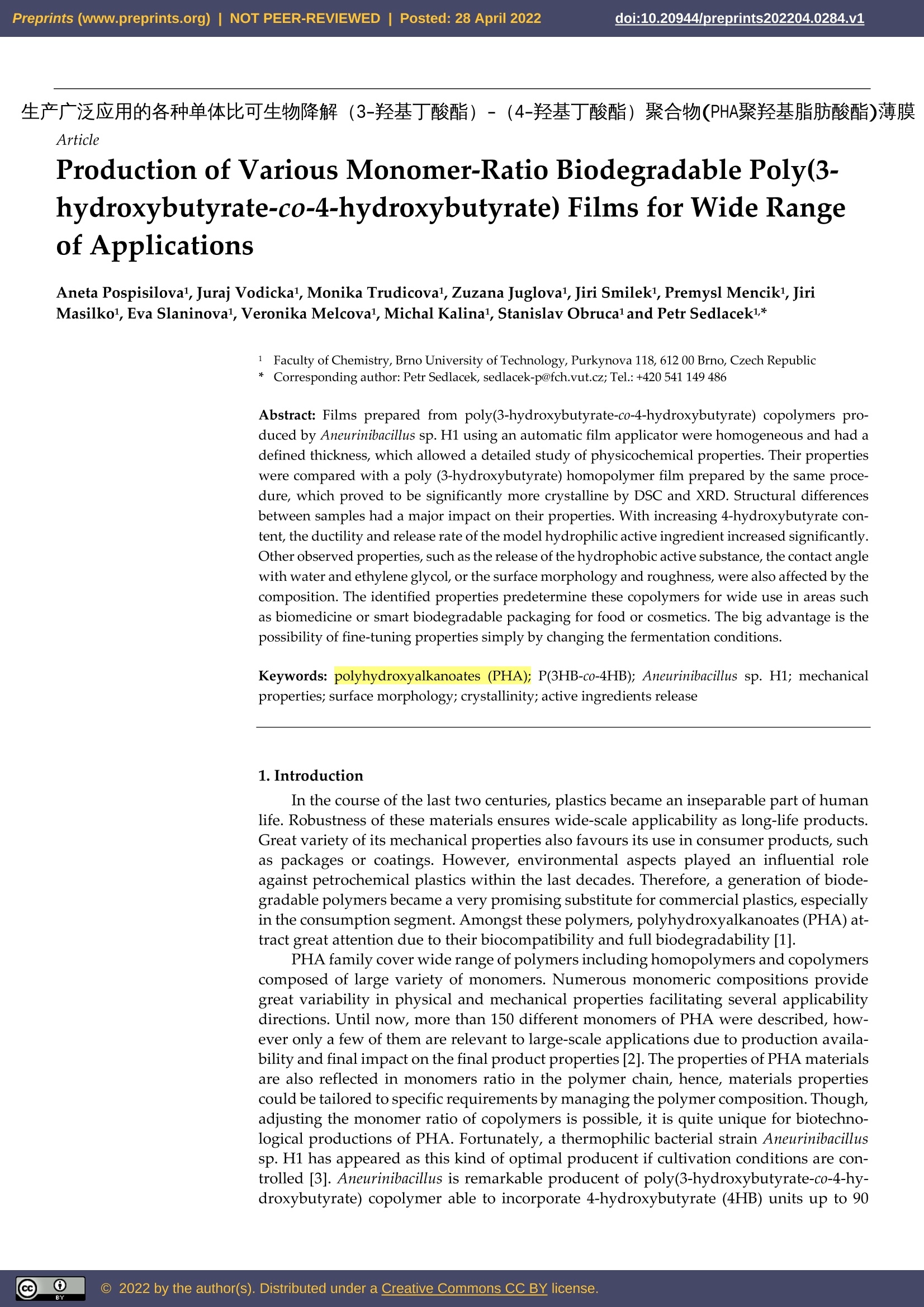
-
2/11
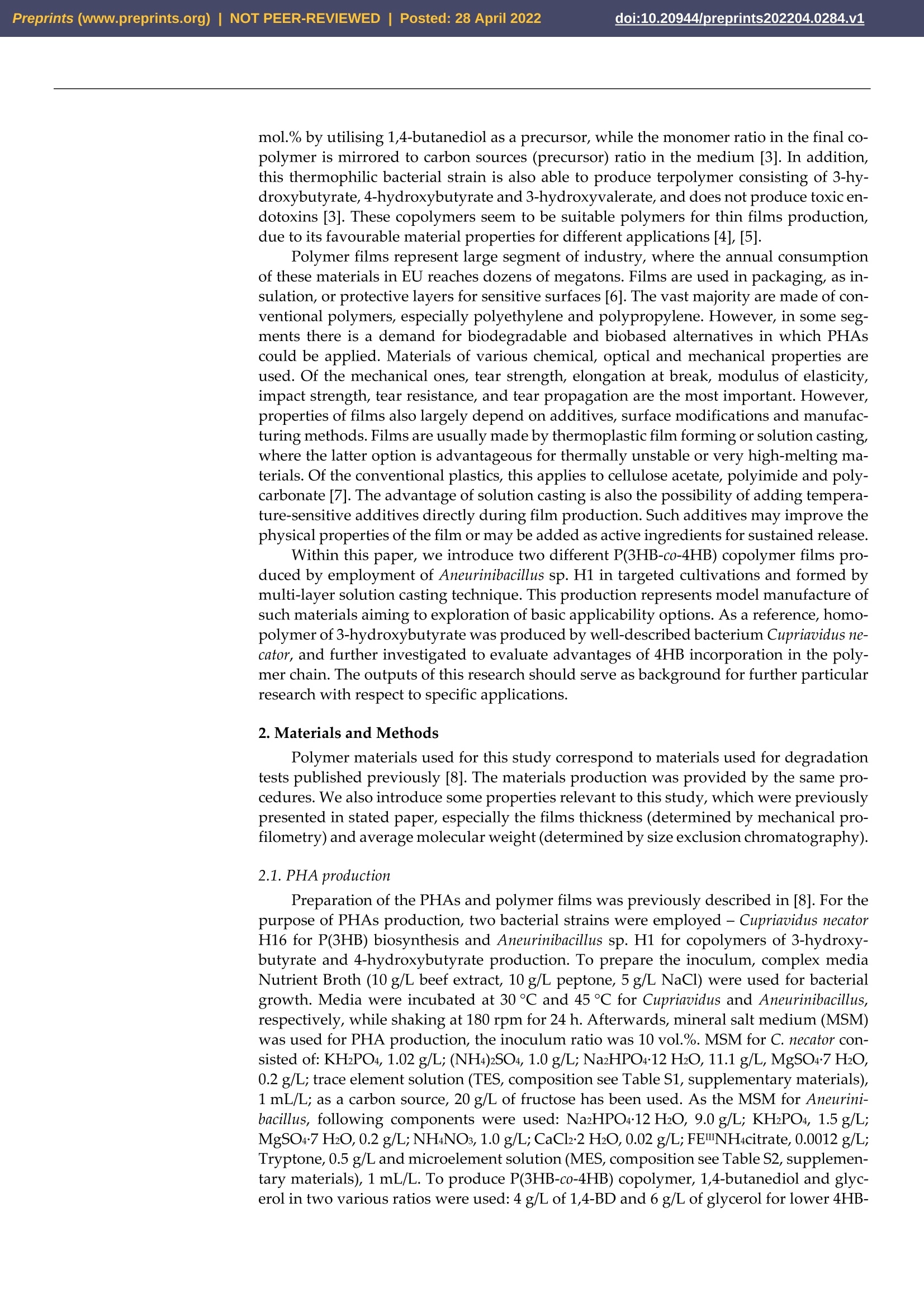
还剩9页未读,是否继续阅读?
继续免费阅读全文产品配置单
中国格哈特为您提供《可生物降解(3-羟基丁酸酯)-(4-羟基丁酸酯)聚合物(PHA聚羟基脂肪酸酯)薄膜样品的提取》,该方案主要用于可降解材料中含量检测,参考标准《暂无》,《可生物降解(3-羟基丁酸酯)-(4-羟基丁酸酯)聚合物(PHA聚羟基脂肪酸酯)薄膜样品的提取》用到的仪器有格哈特全自动快速溶剂萃取仪Sox416、德国加液器MM、滤纸筒。
我要纠错
推荐专场
快速溶剂萃取设备/快速溶剂萃取仪
更多相关方案


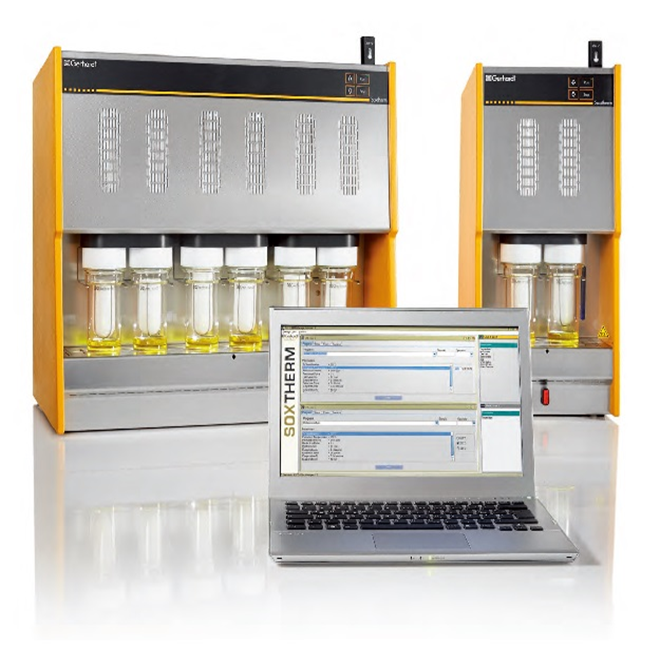
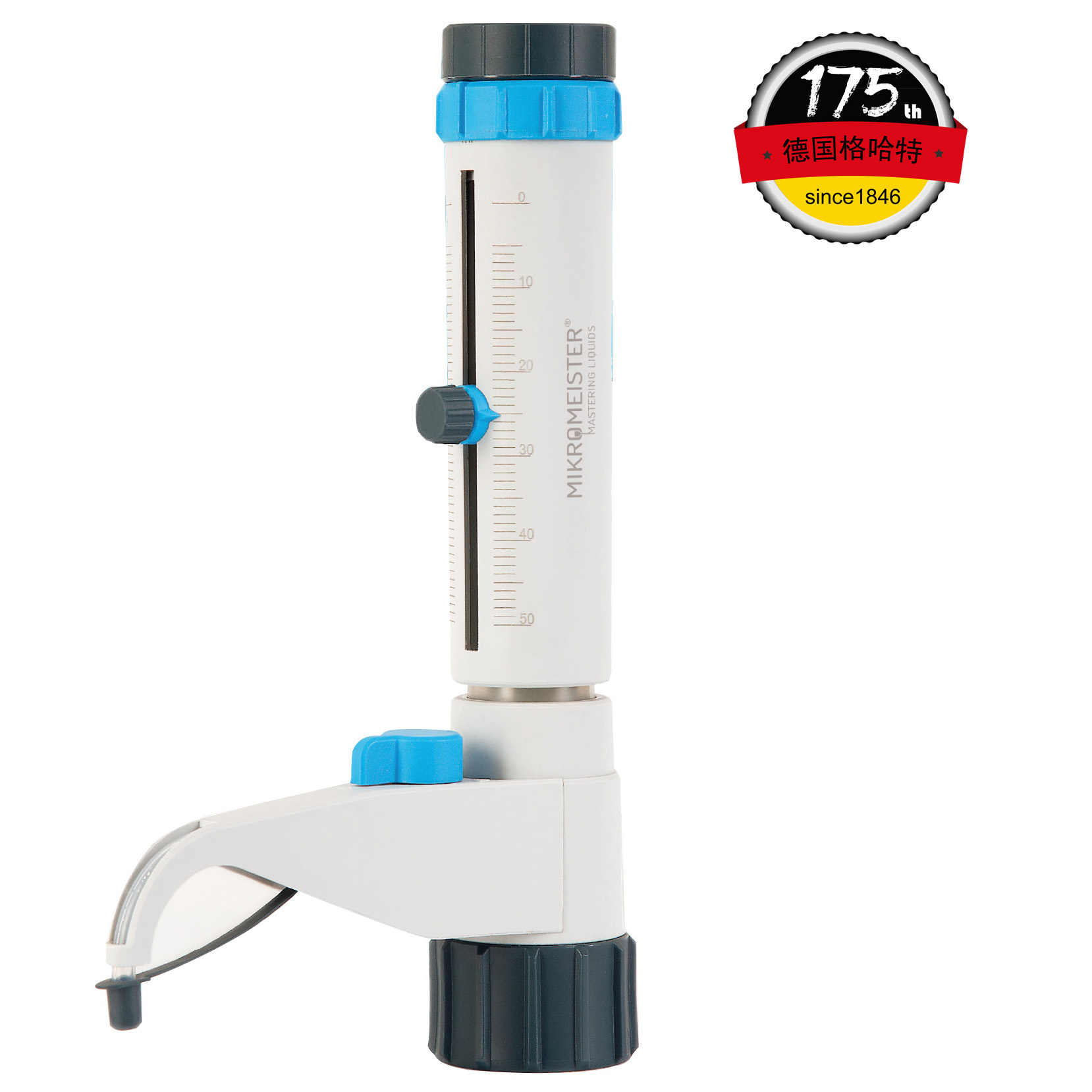
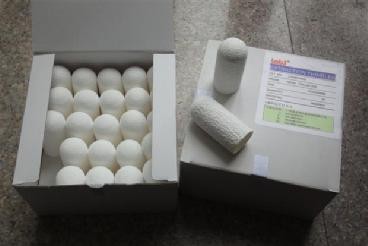
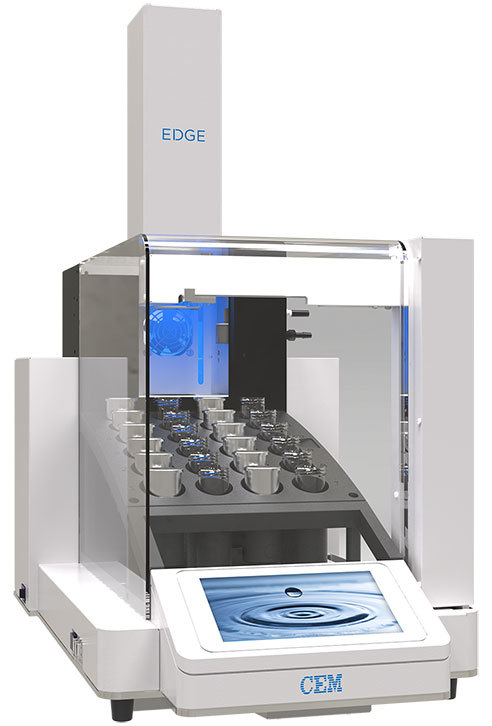
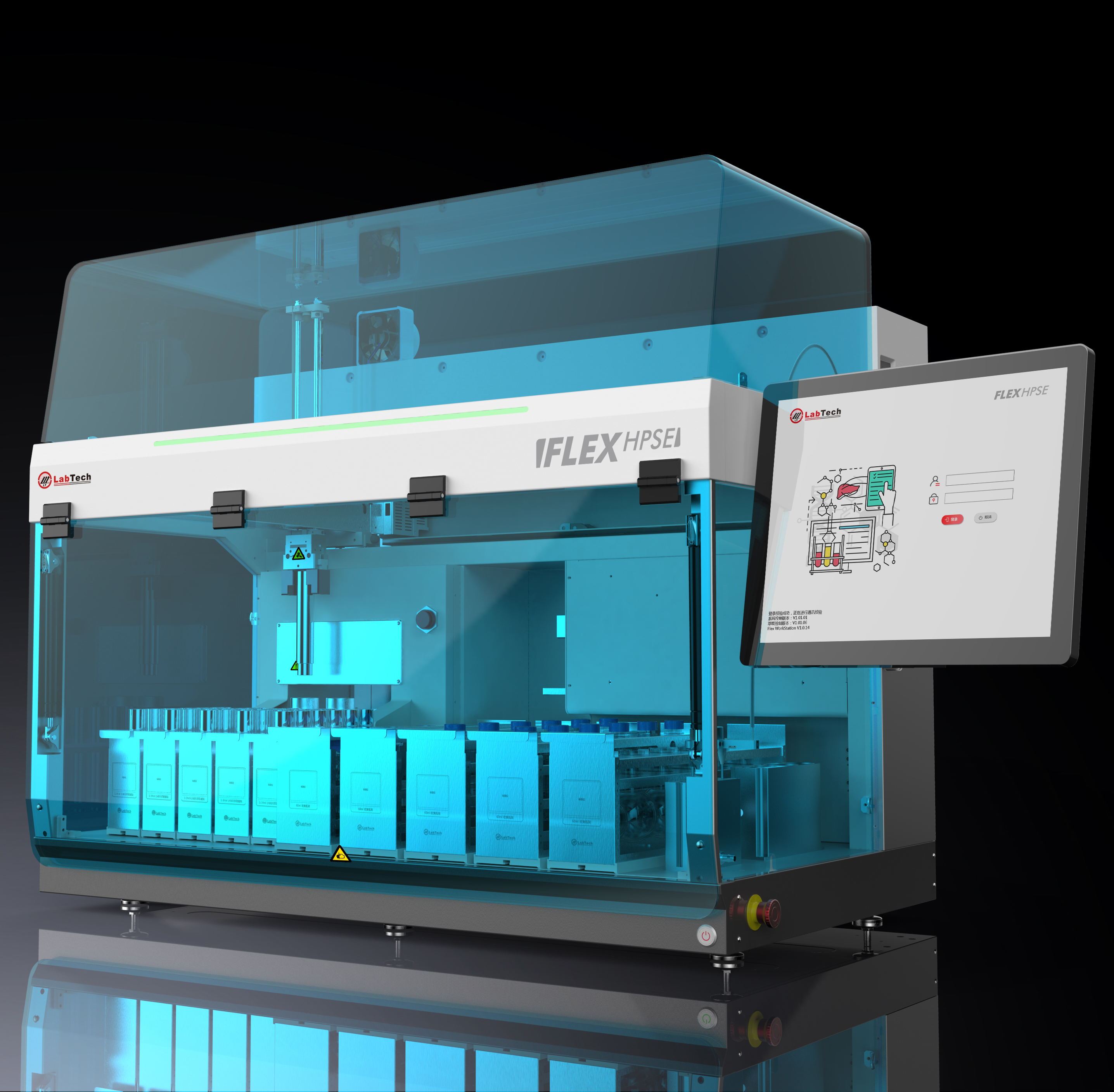
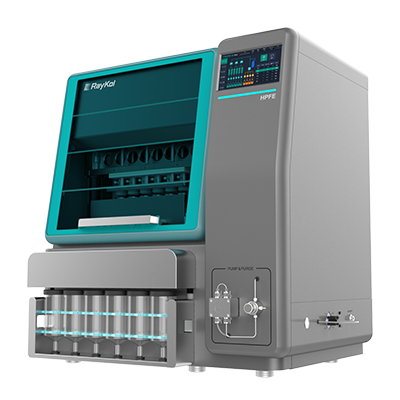



 咨询
咨询